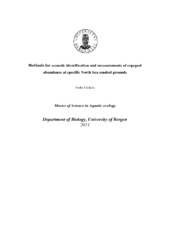Methods for acoustic identification and measurements of copepod abundance at specific North Sea sandeel grounds
Master thesis
Permanent lenke
http://hdl.handle.net/1956/5595Utgivelsesdato
2011-04-15Metadata
Vis full innførselSamlinger
Sammendrag
In recent years there has been a decline in both size and the geographical distribution of the sandeel stock. The decline has been particularly profound in the Norwegian economic zone where the sandeel play an important part not only in terms of economic interests, but also in transferring energy from the planktonic society to the higher trophic levels. If there are not enough copepods to feed on, the sandeel along with several other animals would lose its basis of existence. As a part of the IMR SMASSC (Survey methods for abundance estimation of sandeel (Ammodytes marinus) stocks) project it was decided to develop methods for acoustic identification and abundance estimation of copepods. This was done by comparing biological samples to acoustic abundance estimates using multi frequency methods with the operating frequencies 18, 38, 120 and 200 kHz collected in 2010. These data were to be compared with data collected in 2009 with six operating frequencies 18, 38, 70, 120, 200 and 333 kHz. Results from these studies indicate that 333 kHz is required in most cases to identify copepods, and that the copepod distribution is far too heterogeneous for biological net samples alone to be reliable. Acoustic methods are better suited for mapping geographical distribution of copepods and may also be better suited for abundance estimation of copepods than the time consuming net sampling methods. In addition, sandeel (Ammodyte marinus) digestion rate and gastric evacuation rate were monitored in a tankt. The digestion experiment implies that the sandeel leave the sand to feed once a day at the most. Also, it seems like light, more than the presence of copepods, is the decisive factor of motivation for the sandeel to emerge from the sand.
